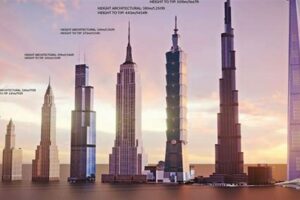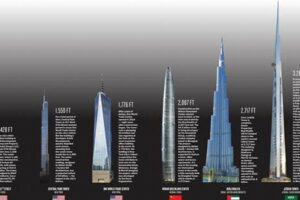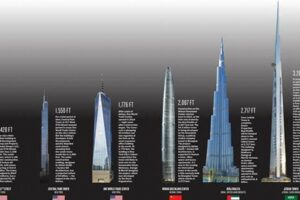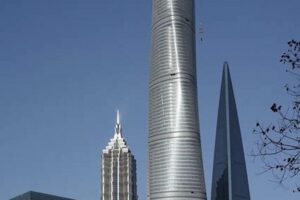In 2008, the tallest skyscraper in North America was the Willis Tower, formerly known as the Sears Tower, located in Chicago, Illinois. Standing at 1,451 feet (442 meters) with 110 stories, it held the title of the tallest building in the United States for over 25 years, from its completion in 1973 until 2013 when it was surpassed by One World Trade Center in New York City.
The Willis Tower is a marvel of architectural engineering, featuring a unique bundled tube structural system that provides exceptional stability and strength. Its exterior consists of nine square tubes, each composed of 59 columns welded together. This innovative design allowed for the construction of a supertall skyscraper without the need for exterior buttresses or bracing, resulting in a sleek and streamlined appearance.
Beyond its architectural significance, the Willis Tower has become an iconic landmark and a popular tourist destination. Its observation deck, known as The Skydeck, offers breathtaking panoramic views of Chicago and Lake Michigan and is one of the most visited attractions in the city. The building also houses numerous offices, retail stores, and restaurants, making it a vibrant hub of commercial activity.
1. Height
In the realm of skyscrapers, height reigns supreme, and the Willis Tower stands tall as a testament to this pursuit. Its elevation of 1,451 feet (442 meters) played a pivotal role in securing its title as the tallest skyscraper in North America in 2008.
- Engineering Prowess: Achieving such an extraordinary height required innovative engineering solutions. The Willis Tower’s bundled tube structural system, pioneered by Fazlur Rahman Khan, revolutionized skyscraper design. This system consists of nine square tubes welded together, providing exceptional strength and stability, allowing the building to withstand high winds and seismic activity.
- Architectural Icon: The Willis Tower’s height and distinctive design have made it an architectural marvel. Its silhouette dominates the Chicago skyline, and its presence has shaped the city’s identity. The building’s exterior features alternating bands of dark and light glass, creating a visually striking effect that sets it apart from other skyscrapers.
- Tenant Attraction: Height can be a significant factor in attracting tenants, as it offers panoramic views and a sense of prestige. The Willis Tower’s elevation has made it a desirable location for businesses and organizations seeking high-profile office space.
- Tourism Destination: The Skydeck, located on the 103rd floor of the Willis Tower, offers breathtaking views of Chicago and Lake Michigan. Its popularity as a tourist destination further enhances the building’s significance and contributes to its economic impact.
In conclusion, the height of 1,451 feet (442 meters) is inextricably linked to the Willis Tower’s standing as the tallest skyscraper in North America in 2008. It represents the culmination of engineering brilliance, architectural prowess, and commercial success, solidifying the Willis Tower’s place in architectural history.
2. Stories
The number of stories in a skyscraper is a crucial factor that contributes to its overall height and status. In the case of the Willis Tower, its 110 stories played a significant role in its recognition as the tallest skyscraper in North America in 2008.
A greater number of stories allows for increased vertical space utilization, enabling the building to accommodate more tenants and functions. In the case of the Willis Tower, its 110 stories provided ample space for offices, retail stores, restaurants, and other commercial uses. This diversity of tenants contributed to the building’s economic viability and its status as a hub of business activity.
Furthermore, the number of stories in a skyscraper can impact its structural stability and wind resistance. A well-designed skyscraper must be able to withstand strong winds and seismic forces, and the Willis Tower’s 110 stories were carefully engineered to ensure its structural integrity. The building’s bundled tube structural system, combined with its 110 stories, provides exceptional strength and stability, allowing it to withstand high winds and earthquakes.
In conclusion, the 110 stories of the Willis Tower were not merely a numerical figure but played a vital role in its designation as the tallest skyscraper in North America in 2008. They enabled the building to accommodate a diverse range of tenants, contributed to its structural stability, and enhanced its overall functionality and economic viability.
3. Location
The location of the Willis Tower in Chicago, Illinois, played a significant role in its recognition as the tallest skyscraper in North America in 2008. Chicago has a long history of architectural innovation and is home to many notable skyscrapers, including the John Hancock Center and the Trump International Hotel and Tower. The city’s central location within the United States and its position as a major transportation hub made it an ideal site for the construction of a supertall skyscraper.
The availability of skilled labor and resources in Chicago also contributed to the successful completion of the Willis Tower. The city is home to a large pool of architects, engineers, and construction workers, and it has a well-developed infrastructure to support large-scale construction projects. Additionally, Chicago’s proximity to major transportation routes, such as the Great Lakes and the Mississippi River, facilitated the efficient delivery of materials and equipment to the construction site.
Beyond the practical advantages, Chicago’s cultural and economic landscape also played a role in the Willis Tower’s development. The city’s strong economy and its status as a global financial center attracted businesses and investors who were eager to occupy space in a prestigious skyscraper. The Willis Tower’s central location within the city’s business district made it an ideal choice for companies seeking a prominent and accessible address.
In conclusion, the location of the Willis Tower in Chicago, Illinois, was a key factor in its designation as the tallest skyscraper in North America in 2008. The city’s architectural legacy, skilled workforce, transportation infrastructure, and economic vitality all contributed to the successful construction and operation of this iconic building.
4. Structural System
The bundled tube structural system played a pivotal role in the Willis Tower’s recognition as the tallest skyscraper in North America in 2008. This innovative system, pioneered by structural engineer Fazlur Rahman Khan, revolutionized skyscraper design and enabled the construction of supertall buildings with unprecedented height and stability.
- Exceptional Strength and Stability: The bundled tube system consists of multiple vertical tubes, or “bundles,” arranged around a central core. These tubes are connected by horizontal beams and trusses, creating a rigid and load-bearing structure. This design provides exceptional strength and stability, allowing the building to withstand high winds and seismic forces.
- Reduced Wind Resistance: The bundled tube system’s shape and orientation minimize wind resistance. The rounded corners of the tubes and the staggered arrangement of the bundles help to deflect wind forces, reducing the overall load on the structure.
- Efficient Use of Space: The bundled tube system allows for a more efficient use of space within the building. The vertical tubes are located around the perimeter of the building, leaving the central core free for elevators, stairwells, and other essential services.
- Architectural Flexibility: The bundled tube system provides architects with greater flexibility in designing the exterior of the building. The tubes can be clad in different materials and textures, creating a variety of aesthetic effects.
In conclusion, the bundled tube structural system was a key factor in the Willis Tower’s success as the tallest skyscraper in North America in 2008. Its exceptional strength, stability, and efficiency made it possible to construct a building of unprecedented height and architectural significance.
5. Observation Deck
The Observation Deck, known as The Skydeck, is an integral component of the Willis Tower, formerly known as the Sears Tower, which held the title of the tallest skyscraper in North America in 2008. The Skydeck is located on the 103rd floor of the building, offering breathtaking panoramic views of Chicago and Lake Michigan, making it a popular tourist destination and a key contributor to the building’s significance.
The Skydeck’s elevated position provides visitors with a unique perspective of the city and its surroundings. On a clear day, visitors can see up to 50 miles in all directions, taking in iconic landmarks such as Millennium Park, Buckingham Fountain, and Wrigley Field. The Skydeck also features interactive exhibits and educational displays that provide insights into the history and architecture of the Willis Tower and Chicago.
The Skydeck’s popularity as a tourist destination has a positive economic impact on the Willis Tower and the surrounding area. It attracts visitors from around the world, generating revenue and supporting local businesses. Additionally, the Skydeck has become a symbol of Chicago’s architectural prowess and a must-visit destination for tourists exploring the city.
In conclusion, the Observation Deck: The Skydeck is an essential component of the Willis Tower’s identity as the tallest skyscraper in North America in 2008. Its elevated position, panoramic views, and educational exhibits enhance the building’s appeal to tourists and contribute to its economic and cultural significance.
6. Completion Year
The completion year of 1973 played a pivotal role in the Willis Tower’s recognition as the tallest skyscraper in North America in 2008. This significant milestone marked the culmination of years of meticulous planning, innovative engineering, and architectural prowess.
- Architectural Innovation: The Willis Tower’s completion in 1973 showcased groundbreaking architectural advancements. Its bundled tube structural system, pioneered by Fazlur Rahman Khan, revolutionized skyscraper design and enabled the construction of supertall buildings with unprecedented height and stability.
- Economic Boom: The 1970s witnessed a period of economic growth and urban development in the United States. The construction of the Willis Tower reflected the optimism and ambition of the era, symbolizing Chicago’s status as a global financial and commercial hub.
- Height Record: Upon its completion, the Willis Tower surpassed the World Trade Center as the tallest building in the world. This achievement brought international recognition to Chicago and solidified the city’s place among the world’s leading architectural centers.
- Cultural Significance: The Willis Tower quickly became an iconic landmark and a symbol of Chicago’s architectural heritage. Its distinctive silhouette has been featured in numerous films, television shows, and other cultural works, further enhancing its cultural significance.
In conclusion, the completion year of 1973 is inextricably linked to the Willis Tower’s standing as the tallest skyscraper in North America in 2008. It represents a confluence of architectural innovation, economic growth, and cultural significance, solidifying the Willis Tower’s place in architectural history.
7. Architect
The connection between Fazlur Rahman Khan, the architect behind the Willis Tower, and its recognition as the tallest skyscraper in North America in 2008 is profound. Khan’s innovative structural designs and engineering prowess were instrumental in pushing the boundaries of skyscraper construction and making the Willis Tower an architectural marvel.
Khan’s bundled tube structural system, employed in the Willis Tower, revolutionized skyscraper design. This system consists of nine vertical tubes bundled together, providing exceptional strength and stability. It allowed for the construction of a supertall building that could withstand high winds and seismic forces, making it possible to achieve the unprecedented height of 1,451 feet.
Khan’s vision and expertise extended beyond structural engineering. He also emphasized the importance of integrating architectural aesthetics with structural functionality. The Willis Tower’s distinctive exterior, with its alternating bands of dark and light glass, reflects Khan’s commitment to creating visually appealing and iconic structures.
The Willis Tower’s enduring legacy as the tallest skyscraper in North America for over two decades is a testament to Fazlur Rahman Khan’s architectural genius. His innovative designs and engineering solutions continue to inspire architects and engineers worldwide, shaping the skylines of cities and pushing the limits of architectural possibility.
8. Status
The Willis Tower’s status as the tallest building in the United States from 1973 to 2013 is inextricably linked to its recognition as the tallest skyscraper in North America in 2008. This status served as a testament to the building’s architectural prowess and engineering marvel, solidifying its place in architectural history.
The Willis Tower’s reign as the tallest building in the United States for over four decades showcased its enduring structural integrity and design excellence. Its bundled tube structural system, pioneered by Fazlur Rahman Khan, provided exceptional strength and stability, allowing it to withstand high winds and seismic activity. This innovative design became a benchmark for future skyscraper construction, demonstrating the practical significance of the Willis Tower’s status.
Furthermore, the Willis Tower’s status as the tallest building in the United States attracted global attention and recognition. It became a symbol of American architectural achievement and a point of pride for Chicago. The building’s iconic silhouette has been featured in countless films, television shows, and other cultural works, further enhancing its cultural significance and reinforcing its status as a national landmark.
Frequently Asked Questions about the Tallest Skyscraper in North America 2008
This section addresses common questions and misconceptions surrounding the Willis Tower, formerly known as the Sears Tower, which held the title of the tallest skyscraper in North America in 2008.
Question 1: What is the height of the Willis Tower?
Answer: The Willis Tower stands at 1,451 feet (442 meters) tall, with 110 stories.
Question 2: Where is the Willis Tower located?
Answer: The Willis Tower is located in Chicago, Illinois, USA.
Question 3: Who was the architect of the Willis Tower?
Answer: The Willis Tower was designed by architect Fazlur Rahman Khan.
Question 4: When was the Willis Tower completed?
Answer: The Willis Tower was completed in 1973.
Question 5: What is the structural system used in the Willis Tower?
Answer: The Willis Tower utilizes a bundled tube structural system, pioneered by Fazlur Rahman Khan.
Question 6: What is the observation deck of the Willis Tower called?
Answer: The observation deck of the Willis Tower is known as The Skydeck.
In conclusion, the Willis Tower stands as a testament to architectural innovation and engineering prowess. Its height, location, architect, and structural system have all contributed to its recognition as the tallest skyscraper in North America in 2008.
Continue reading to explore more fascinating aspects of this architectural marvel.
Tips Related to the Tallest Skyscraper in North America 2008
The Willis Tower, formerly known as the Sears Tower, held the title of the tallest skyscraper in North America in 2008. Several crucial factors contributed to this achievement, providing valuable lessons for architects, engineers, and urban planners.
Tip 1: Embrace Innovation in Structural Design
The Willis Tower’s bundled tube structural system, pioneered by Fazlur Rahman Khan, revolutionized skyscraper construction. By utilizing multiple vertical tubes connected by horizontal beams, this design provides exceptional strength and stability, enabling the building to withstand high winds and seismic forces. Architects and engineers should explore innovative structural solutions to push the boundaries of building height and safety.
Tip 2: Prioritize Sustainability and Energy Efficiency
Skyscrapers significantly impact the environment, consuming vast amounts of energy and resources. The Willis Tower incorporates sustainable design elements, such as double-paned windows and a rainwater collection system, to reduce its environmental footprint. Sustainable practices should be at the forefront of skyscraper design and construction to minimize their ecological impact.
Tip 3: Integrate Mixed-Use Functionality
The Willis Tower accommodates a diverse range of uses, including offices, retail stores, and restaurants. This mixed-use approach creates a vibrant and dynamic urban environment. Architects should consider incorporating multiple functions into skyscraper designs to optimize space utilization and enhance the surrounding neighborhood.
Tip 4: Utilize Observation Decks for Public Engagement
The Willis Tower’s Skydeck offers breathtaking views of Chicago, attracting millions of visitors annually. Observation decks provide a unique opportunity to connect the public with skyscrapers and showcase the architectural achievements of a city. Architects should consider incorporating observation decks into their designs to enhance the building’s appeal and foster a sense of community.
Tip 5: Respect the Architectural Heritage
The Willis Tower has become an iconic landmark and a symbol of Chicago’s architectural legacy. When designing new skyscrapers, architects should be mindful of the existing urban fabric and strive to create structures that complement and enhance the surrounding environment, preserving the city’s architectural heritage.
In conclusion, the Willis Tower, as the tallest skyscraper in North America in 2008, exemplifies the convergence of architectural innovation, sustainability, functionality, public engagement, and respect for heritage. By incorporating these principles into skyscraper design, architects and engineers can create structures that not only reach new heights but also positively impact the urban environment and enrich the lives of their occupants.
Conclusion
The Willis Tower, formerly known as the Sears Tower, stood as the tallest skyscraper in North America in 2008, a testament to architectural innovation and engineering prowess. Its height, structural system, and iconic status have made it a symbol of Chicago and a landmark in the global architectural landscape.
The building’s success highlights the importance of embracing innovation, prioritizing sustainability, and integrating mixed-use functionality. It also underscores the value of observation decks in connecting the public with architectural achievements and the significance of respecting architectural heritage when designing new structures.
As we look to the future of skyscrapers, the lessons learned from the Willis Tower will continue to guide architects and engineers in creating structures that not only reach new heights but also contribute positively to their surrounding urban environments and the lives of their occupants.







